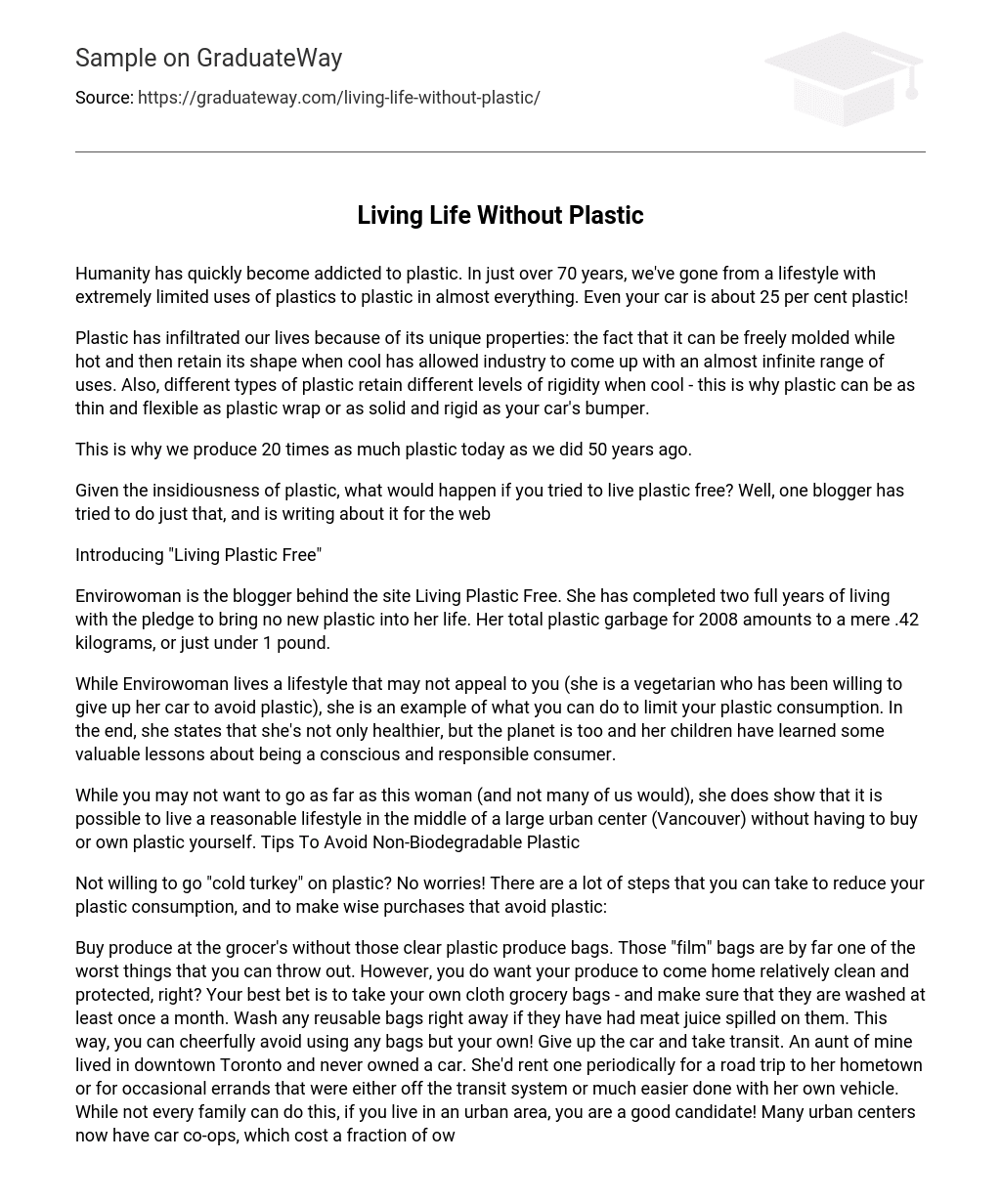In a span of only 70 years, humanity has rapidly developed a dependence on plastic. From a time when the applications of plastics were incredibly limited, we now find them present in almost all aspects of our lives. Even automobiles contain approximately 25% plastic!
Plastic has become a significant part of our daily lives due to its distinct characteristics. Its ability to be easily shaped when heated and maintain its form when cooled has allowed various industries to create an extensive array of products. Furthermore, the level of rigidity exhibited by different types of plastic when cooled varies, which explains why plastic can be as thin and flexible as wrap or as strong and firm as a car’s bumper.
Today, we produce 20 times more plastic than we did 50 years ago.
One blogger has attempted to live a plastic-free lifestyle and is documenting their experiences on the web to shed light on the harmful effects of plastic.
Introducing the concept of “Living Plastic Free”.
Envirowoman, the blogger of Living Plastic Free, has successfully lived without introducing any new plastic into her life for two entire years. In 2008, her total plastic waste was only .42 kilograms, which is equivalent to just under 1 pound.
Envirowoman demonstrates ways to reduce plastic consumption through her lifestyle choices, such as being a vegetarian and foregoing a car. Despite not necessarily appealing to everyone, her practices serve as an example for minimizing plastic use. Envirowoman emphasizes that not only is she healthier as a result, but the planet benefits as well, and her children gain valuable knowledge on conscious and responsible consumption.
Although few individuals would go to the same extent as this woman, she serves as an example that living a sustainable life in Vancouver without plastic ownership is achievable. Here are some suggestions for avoiding non-biodegradable plastic.
Don’t worry if you’re not ready to completely stop using plastic! You can still take many actions to decrease your plastic usage and make informed purchases that avoid plastic.
To reduce waste, avoid using plastic produce bags when purchasing groceries and opt for cloth grocery bags instead. Remember to wash them regularly and clean any spills immediately. By following these steps, you can minimize the use of external bags. Similarly, consider using public transportation instead of relying on a car, especially in urban areas where alternatives are readily available. Car co-ops offer cost-effective options that help save both plastic waste from single-family vehicles and repair materials. Additionally, purchase fresh produce without plastic packaging by filling your basket directly with fruits and vegetables. For more tips on minimal packaging and acquiring larger quantities of food, refer to my article on this topic. Lastly, investing in a reusable water bottle is crucial as the number of hazardous plastic water bottles continues to rise.The sales of bottled water in the United States have consistently risen, surpassing 31 billion liters.
All plastic water bottles alone consume over 17 million barrels of oil. However, this oil could be used for more essential purposes, such as critical medical equipment that relies on plastic for life-saving treatments. To minimize waste, choose products with recyclable or minimal packaging. When faced with the options of no packaging, fully recyclable packaging, or conventional packaging, prioritize products without packaging, followed by those in fully recyclable packaging. Avoid purchasing items if the only available packaging option will ultimately contribute to waste. Opt for materials like cardboard, paper, metal, and glass as they offer the best recycling options. Supporting local businesses not only reduces the need for long-distance transportation but also results in less plastic packaging and more nutrient-rich food. Look for companies that prioritize recycling in their practices. For example, switch to toilet paper made from post-consumer waste and use the same principle for paper towels. Alternatively, consider using reusable cloths for spills and wipes in your kitchen. Simply place them in your dishwasher every night to have clean, bacteria-free cloths available in the morning. Embrace your creativity by making your own greeting cards using materials like magazines and craft supplies found at home.
There are several ways to be more eco-friendly in your daily life. One option is to make your own gift wrap and gift bags, which you can learn about in my article on eco-friendly kid’s parties. Another idea is to find a new coffee table at a garage sale or auction and refinish it yourself. Additionally, you could join a CSA (Community Shared Agriculture), where you buy a share of produce from a farm, supporting organic farmers and learning more about your food. If you’re female, consider trying a menstrual cup – a reusable alternative that has been around for 75 years. I personally started using one after the birth of my first child and have never looked back. Menstrual cups are comfortable, virtually leak proof when worn properly, and can last up to 10 years without creating any waste. Simply follow the cleaning instructions, sterilize it with steam, and store it until needed again.





